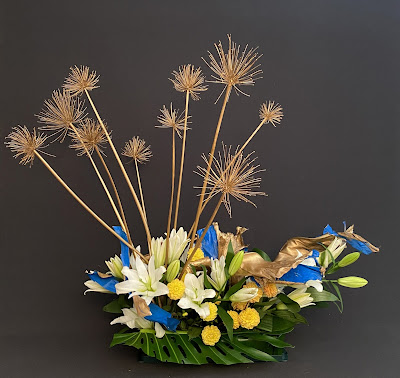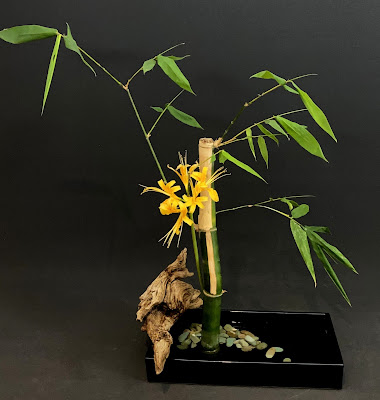 |
| Philip and Shirley Keon |
This past week has been a sad one with the passing of two members of our kebana community, Cherie Glaser and Philip Tobin Keon.
Cherie was one of the earliest members of both our Sogetsu group and Ikebana International. She began her studies with Norman Sparnon. I did not know Cherie very well, as she was a little before my time but I'm grateful to have had the opportunity to see her at our last Sogetsu meeting, when she came, despite ill health, with the help of her daughter. I enjoyed speaking with her and was most impressed by her positivity.
Philip and I were taught by the same teacher, Carlyne Patterson, albeit not at the same time, so we knew each other fairly well. He had a very unique, creative style both in the work that he did and his sartorial sense. He was always immaculately attired and was never afraid of colour. If I had to find one word to describe Philip, it would be 'dapper'.
When I was asked to make the coffin arrangement for Philip's funeral, I consulted Shirley as to what she wanted from me. She said she wanted it to be flamboyant and spectacular and to forget the 'less is more' policy. I remembered that Philip liked to use a particularly bright, almost electric blue colour in his work and decided to use the same colour.
I had four dried, strelitzia nicolai leaves which I sprayed gold on the outside and painted blue on the inside as the basic structure. I then added two bunches of white Oriental lilies and two bunches of yellow dahlias. I also used monstera deliciosa leaves cut sharply and placed as a kind of skirt around the oasis holders. To top it all off, I used dried and sprayed gold agapanthus stems to simulate fireworks. I would like to think that Philip would have approved.
On a happier note, my granddaughter Hermione had a birthday and celebrated it at a venue which specialises in Harry Potter themed parties. As you can probably guess, Hermione was named after Hermione Granger of Harry Potter fame.
The naming of this child is interesting. Her mother, Jeannine, loved the Harry Potter books as a child and wanted to name her first daughter Hermione. As it turns out, my Greek name is 'Ermioni', the female version of 'Ermis', the messenger God of Olympus. The English name Hermione is derived from 'Ermioni'. This was a lucky coincidence for Jeannine because her husband, Dennis, would not have agreed to the name had it not been, also, his mother's name. You may well ask why I am now called Emily. It's because the teacher, who enrolled me into the primary school I went to straight off the boat, could not pronounce 'Ermioni' and announced that I would be called 'Emily'.
 |
| The birthday girl as Hermione Granger |
 |
| Very large glass vase with agapanthus heads inside and outside the vase. The line is New Zealand flax |
 |
| Half of monstera deliciosa leaf, Japanese anemones and amaranthus |






















































